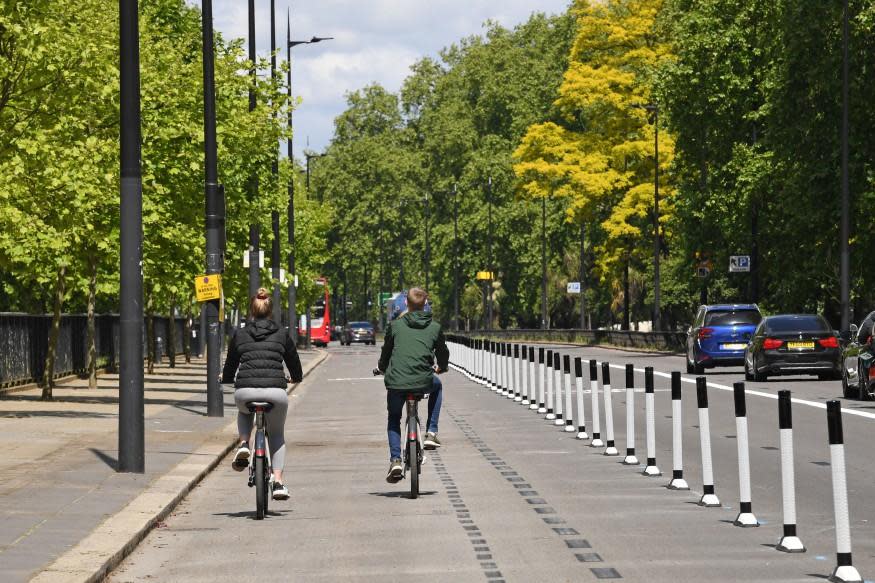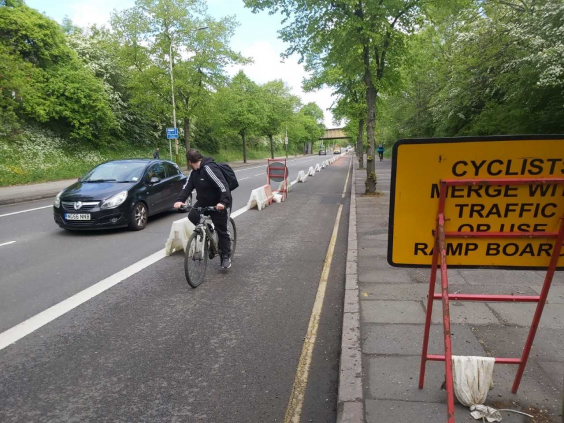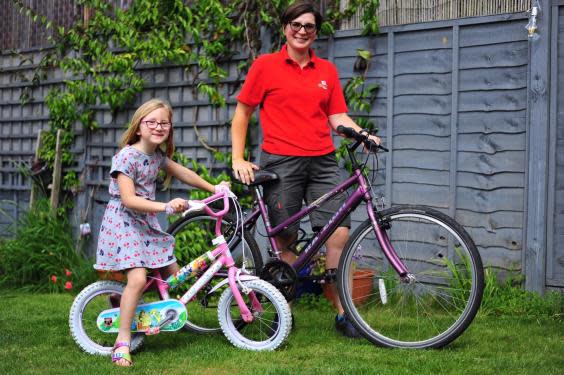The cyclist’s century? How coronavirus could reshape UK cities and towns around two-wheel travel ‘for generations to come’

It is a pandemic that has spread misery across the world, brought economies to their knees and trapped millions of people in their own homes.
But coronavirus, it seems, may also fundamentally reshape our towns and cities for generations to come.
Specifically, it may lead to them being reshaped around bikes and pedestrians.
Figures released by Sport England this week show that the number of people cycling during lockdown has almost doubled from eight to 15 per cent, while bike shops are reporting record numbers of sales.
Now, with local councils across the UK installing more than 100 temporary road changes to accommodate more socially distanced two-wheel travel, campaigners and analysts believe the shift could become permanent.
Their hope is not only that this raft of pop-up bike lanes, interim traffic bans, widened pavements and short-term speed limit reductions will turn into established fixtures, but, crucially, that there will also be a shift within town halls towards prioritising such schemes in future.
“We have been told for decades that we will never have loads of people cycling in England, that it’s different to places abroad because it’s not as flat or it’s wetter or there are too many hills,” Duncan Dollimore, head of advocacy with Cycling UK, tells The Independent today. “But what the Covid crisis has shown us is that people here will cycle – if they think it’s safe.
“The last 12 weeks have effectively been a massive social experiment where we have seen what happens when the roads are quieter – and millions of people have responded by jumping on bikes for the first time in years or, indeed, for the first time ever.”
His conclusion? “If we are enabled to cycle – not just encouraged but actually enabled – millions of us will do it… Now our built environment must reflect that finding.”
Such enabling changes – implemented to allow greater socially distanced travel while also promoting better respiratory health – have been installed everywhere from Aberdeen to Exeter, and from Belfast to Cardiff.
They include a seven-mile pop-up cycle lane on the A56 between Trafford and Manchester city centre (“in 40 years,” tweeted one user, “probably the first time I’ve felt safe”); the pedestrianisation of a swathe of Brighton sea front, and a new barrier-protected cycle lane on Leicester’s arterial Aylestone Road – created specifically for NHS workers wanting a safer way to the city’s hospital.
More? London’s Park Lane is one of dozens of roads across the capital where segregated bike lanes have been created with bollards, while a portion of York’s inner ring-road has been given over to cyclists.
Liverpool may go even further: it is considering a £2 million package to introduce 100km of temporary lanes in and out of the centre – with a view to then keeping them in place once the pandemic is over. “A once in a lifetime opportunity to reimagine how we use and travel within our cities,” is how Mayor Joe Anderson described the proposals.

“The joy of temporary schemes like these is that communities get to try before they buy,” says Mr Dollimore. “There is an opportunity to try it, tweak it if it’s not quite right, and let people see just how good they can be for their towns and cities.
“And I do think a lot of these measures will become permanent because, historically, when biking infrastructure and pedestrianisation has been implemented in the UK, there has quite often been objections from people who, some months later, have said actually, ‘This is great’. I expect that will happen with this.”
In a special (pre-coronavirus) report in January, The Independent interrogated the idea that the UK city is moving towards a pedestrian age. With cyclist numbers already slowly growing, rising concerns about global warming, and cities like York and Birmingham mooting car-free futures, we reckoned that it probably was – but it would take some time.
Now, however, there is some feeling that Covid-19 may have just condensed a decade’s worth of attitude change into 12 weeks.
“My sense is that, on the back of this crisis, there is a momentum to create a city that is better for walkers and cyclists,” says Jonny Crawshaw, the York City Council member who first proposed a now-approved motion to make the North Yorkshire city car free by 2023. “The last three months, people have experienced less congested, less polluted roads – they can hear birds singing as they walk into York – and now they want their local councils to find ways to keep as many of these changes as possible.”
It is now more likely that his own council’s ambitions to become pedestrianised within three years will be realised? “It’s a huge challenge… but I would hope so,” he replies. “People who were more sceptical before – some business-owners and motorists; not all but some – are now looking at how these temporary cycle lanes are working and they’re acknowledging this may be a future that can work.”
The schemes, it should be said, are not without controversy. Local newspapers across the country have been filled with business bosses saying they fear lost trade if the new road measures are still in place when towns reopen.
But crucially, hopes Councillor Crawshaw, temporary measures will allow data to be created that proves fewer cars does not equate to reduced economic activity.
“The fear from business is always if you reduce cars, you reduce footfall and business but, in reality, that’s almost never the case,” he says. “Hopefully temporary measures will show that.”

Certainly, a more cycle-friendly future would work for Bernadette Bedford.
The postwoman, of Hastings, has been riding to work throughout the pandemic after receiving a bike through a Cycling UK scheme – the Big Bike Revival – to help key workers on to two wheels.
“It’s been lovely,” says the mother-of-two who previously got a lift with husband Jonathan. “By chance my daughter has just learnt to bike without stabilisers – so proud – so it’s been really encouraging for her to see me going to work like this.”
No temporary bike lanes have been constructed along her own two-mile journey but, because the roads have been largely traffic-free, she has felt safe.
“But that’s starting to creep up again now,” the 37-year-old admits. “Which does make me a bit uneasy. Will I carry on if things go back to normal? I’d like to but I’m not sure. I’m perhaps not confident enough to bike in too much traffic.”
It is a point of view that appears to support the common refrain that, if more facilities existed, more people would use them.
It is one, indeed, that the government has already promised to back with cash.
A £2 billion investment in walking and cycling infrastructure announced in February has been widely welcomed by campaign groups – albeit, as some point out, it could be conceived as relatively small beer compared with spending on roads.
Nonetheless, back with Mr Dollimore, he is convinced that, if central and local authorities are wise, this will indeed be the moment the UK pivots towards two-wheel travel.
“We have a golden opportunity to change the way people move around our urban areas but they have to act now,” he says. “The opportunity is here to embed behavioural change for generations to come – change that would be good for public health and for the environment – but it is now down to councils and government to ensure these temporary facilities remain and are expanded on.
“What they do in the next 10 weeks will determine how our towns and cities look for years to come.”
Read more
A car-free future? How UK cities are moving towards a pedestrian age
Blair tells government mass virus testing regime must be introduced
Test and trace system not expected to be ‘world-class’ until September
Why is spending on coronavirus vaccine research a good investment?
NHS facing more cyber-attacks since coronavirus outbreak
UK coronavirus death toll rises by 176 to 39,904
Genes ‘may leave some people more vulnerable to coronavirus’


